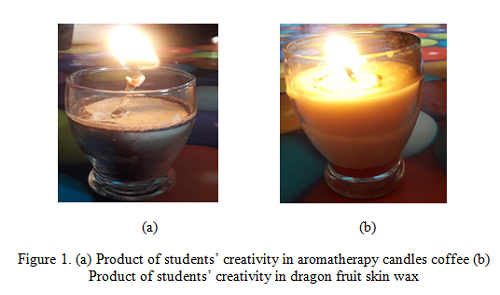
Students’ Creativity in Creating Aromatherapy Candle using Petroleum Learning Design with Radec Model
Abstract
The purpose of this study was to observe whether the examined learning design can improve students' creativity. at the petroleum lesson by using the examined learning design. This research was conducted in Madrasah Aliyah Negeri 2 Takengon. The preferred samples were three second-grade students, a chemical teacher, and two expert lecturers. In this study, the method was descriptive. as it involved two experts, who were lecturers, a chemical teacher, and three second-grade high school students. The data collections were carried out through external and internal feasibility tests. An internal feasibility test was conducted on the chemistry teacher and two expert lecturers, while an external feasibility test was conducted on the three second-grade students. Based on the results, the score results in almost every RADEC stage with a percentage of 91.6% and categorized as very strong, except for the sub-indicator of development creativity or enriching ideas acquired scores of 83.3%. These results imply that petroleum oil learning design with the RADEC model is applicable in the learning process to develop students’ creativity. students’ creativity could be improved by applying chemical learning that uses this learning design.
Keywords
Full Text:
PDFReferences
Amabile, T. M., & Pratt, M. G. (2016). The dynamic componential model of creativity and innovation in organizations: Making progress, making meaning. Research in organizational behavior, 36, 157-183.
Beghetto, R. A., & Sriraman, B. (2017). Creative contradictions in education. Springer.
Happy, N., & Widjajanti, D. B. (2014). Keefektifan PBL ditinjau dari kemampuan berpikir kritis dan kreatif matematis, serta self-esteem siswa SMP. Jurnal Riset Pendidikan Matematika, 1(1), 48-57.
Riduwan. (2015). Dasar-Dasar Statistika. Bandung: Alfabeta.
Munandar, U. (1992). Mengembangkan Kreativitas dan Bakat Anak. Jakarta: Gramedia.
Siregar, L. (2019). Desain Pembelajaran Polimer Menggunakan Model Read, Answer, Discuss, Explain Dan Create (RADEC) Berbasis Google Classroom Untuk Mengembangkan Penguasaan Konsep Dan Kreativitas Siswa Smk Pada Pembuatan Bioplastik. (Tesis). Universitas Pendidikan Indonesia: Bandung.
Sopandi, W. (2017, September). The quality improvement of learning processes and achievements through the read-answer-discuss-explain-and create learning model implementation. Proceeding 8th Pedagogy International Seminar 2017: Enhancement of Pedagogy in Cultural Diversity Toward Excellence in Education 8(229), 132-139.
Sopandi, W. (2019). Sosialisasi dan Workshop Implementasi Model Pembelajaran RADEC Bagi Guru-Guru Pendidikan Dasar dan Menengah [Dissemination and Implementation Workshop of RADEC Learning Models for Primary and Secondary Education Teachers]. Pedagogia: Jurnal Pendidikan, 8(1), 19-34.
Sugiyono. (2005). Metode Penelitian Kuantitatif Kualitatif Dan R&D. Bandung: Alfabeta.
Wahyu, W. (2015). Peningkatan Efikasi Diri Peserta Didik dalam Pembelajaran Kimia melalui Teknik Jigsaw II. Prosiding Simposium Nasional Inovasi dan Pembelajaran Sains 2015.
Wahyu, W., Suryatna, A., & Kamaludin, Y. S. (2018). The suitability of William’s creativity indicators with the creativity-based worksheet for the junior high school students on designing simple distillation tool. Journal of Engineering Science and Technology (JESTEC), 13(7), 1959-1966.
Wiersma, W., & Jurs, S. (2009). Research methods in education: An introduction. MA: Pearson.
DOI: http://dx.doi.org/10.31258/jes.4.4.p.813-820
Refbacks
- There are currently no refbacks.
Copyright (c) 2020 Wulandari Wulandari, Wawan Wahyu, Wahyu Sopandi

This work is licensed under a Creative Commons Attribution 4.0 International License.
Publisher: FKIP Universitas Riau












